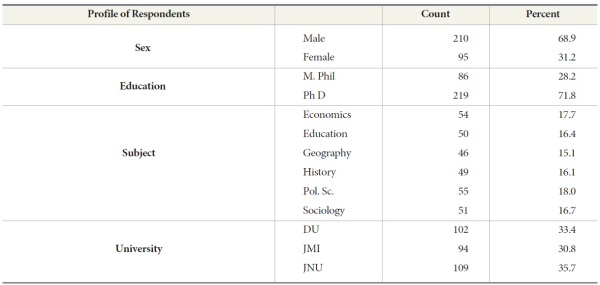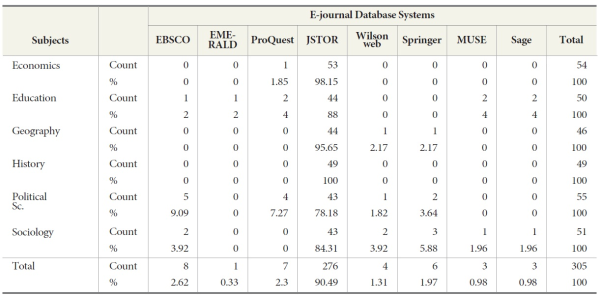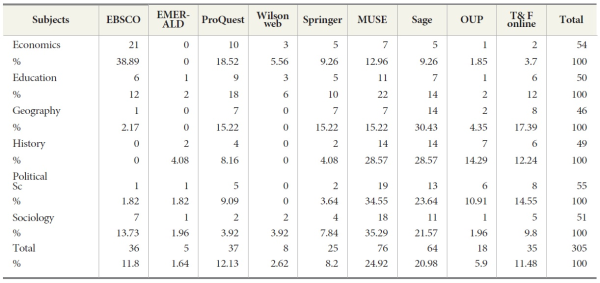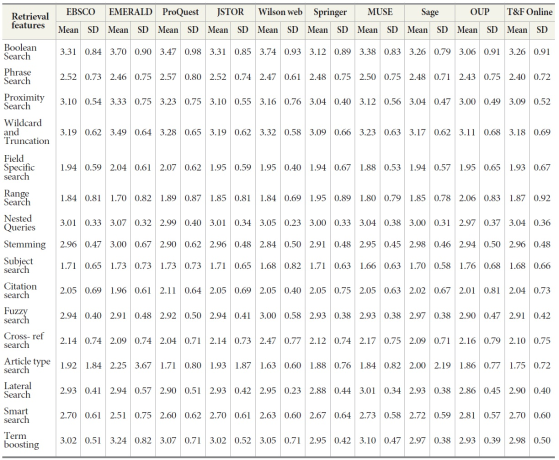ISSN : 2287-9099
Online Searching Behavior of Social Science Researchers’ in IR Interfaces of E-journal Database Systems: A Study on JMI, JNU, and DU

Namrata Rai (Department of Library and Information Science University of Delhi)

Abstract
The aim of this study is to examine the user’s online searching behavior in IR interfaces of e-journal database systems. The study is purely based on survey methods and tries to analyse the online searching behavior of respondents of social science disciplines who were doing research in three target central universities of Delhi (i.e. DU, JMI, and JNU). For measuring the responses of the respondents in IR interfaces of e-journal database systems, a total of 396 questionnaires were distributed among the students and out of all, 305 responses were used for the study. The findings of the study reveal that most of the students were not using all the facilities offered in IR interfaces of e-journal database systems for their retrieval process and also encourages menu based searches rather than command based searching.
- keywords
- e-journal database systems, IR interface, retrieval features, user study, online searching behavior, browsing
1. INTRODUCTION
Information Communication Technology has enabled rapid exchange of information on research thus resulting in an exponential growth of information. The major issues of information explosion are the storage of information and its effective retrieval. The field of information retrieval has come a long way in the last forty years and has enabled easier and faster access of data. For retrieving information, online databases are playing an important role. In today’s environment, online databases come up with various retrieval features which provide assistance to the users in the formulation of their search statements for effective retrieval.
Espelt (1998) states that a large extent of user searches takes place in networked environments that allow for different options for different search contexts like CD-ROMs, OPAC, union catalogues, and selected World Wide Web resources. These systems differ in content, structure, and capabilities. So for effective retrieval of information from these diversified resources, retrieval features plays an important role.
End-user access and use of information retrieval systems has greatly increased in recent years due to the growth of internet based search services. Wolfram (2000) notes that in addition to traditional bibliographic based IR systems such as OPAC in libraries and specialized databases offered through online vendors, users are now able to access vast quantities of electronic resources through the internet. To better understand how users interact with IR interface of ejournal database systems for the retrieval of information, this study is conducted.
2. RESEARCH PROBLEM
This study was conducted to find out respondents’ online searching behavior in IR interfaces of selected ejournal database systems. Here, the online searching behaviour of the respondents covers various attributes, like preferences in searching by using specific e-journal database systems, reasons behind use of e-journal database systems, factors influencing making effective query statements, and the methods to be followed by the respondents for approaching desired information in IR interfaces of e-journal database systems along with solutions followed by respondents who did not get desired information from the initial query statements.
Besides that, respondents have to respond to the level of difficulty while constructing search statement by using the search operators offered in an IR interface and find ways to browse information in IR interfaces of e-journal database systems.
3. SIGNIFICANCE OF THE STUDY
This study provides help to the e-journal database system vendor to make their IR interface more interactive and user-friendly to users. As well, by knowing their online searching behavior in an IR interface, vendors can modify their respective interfaces according to the preferences of users. The study also has implications for other areas like user education and training.
3.1. Limitations of the study
The study has the following limitations:
-
In case of selection of respondents, the random sampling method was difficult to carry out due to due to several factors: Complexity of data gathering methods and the fact that the exact population using these IR interface of e-journal database systems is hard to define; so, for the study a ‘purposive sampling method’ was used.
-
The study was user-centric so Ph.D. and M.Phil. students were chosen for the study, faculty and librarians were excluded from the study due to their lack of interest in filling in the questionnaire.
-
Selection of e-journal database systems also depended upon their common availability in all three target central universities of India.
4. LITERATURE REVIEW
The previous research done on this topic has been studied the three major areas like online searching behavior, retrieval effectiveness of IR interface and browsing of e-journal database systems.
4.1. Online Searching Behavior
In IR interfaces, retrieval aspects play an important role in the search process. The study of online searching behavior - whether of professional searchers or inexperienced users - is critical to the development of online retrieval systems. Understanding how searchers of all types look for information, and how they interact with existing systems, can provide guidelines for searchers’ training and assistance. But more importantly, understanding searching behavior is essential to the design of advanced, user oriented information systems.
This division encompasses the users’ online searching behavior. Martzoukou (2008) argues that development of information literacy skills in the context of web search engines requires deeper understanding of the reasons underlying already established behavioral pattern. In the study, information seeking behavior of 66 PG students was examined and it was found that there is a need to place less emphasis on developing ‘optimal’ search skills through information literacy instruction and to focus on increasing motivation and appreciation of more complex search strategies. Wolfram (2000) examined the various characteristics including the frequency distribution of queries, and browsing persistence at the session level, based on the query session length, to determine the end user searching behavior. Findings reveal that users submit largely unique queries and engage in similar, non-persistent browsing habits (means not browsing much beyond the first one or two pages). User online searching behavior gets examined with the use of query reformulation and relevance feedback. Spink et.al. (1999) concluded that although relevance feedback was not widely utilized by the users query patterns appear to indicate that this feature was useful to the users.
Subject Searching is yet another way which determines users’ online searching behavior. Larson (1991) defined reasonable subject retrieval as between one and twenty items and found that 12 percent of subject searches retrieved the appropriate number. Yu and Young (2004) also analyse transaction logs related to the effects of implementing Web OPAC with interface changes of California State University. The study found that users’ success in subject searching remains problematic. Sife (2013) conducted the study on PG students of Sikoine University of Agriculture, to understand their web searching behaviour. The findings suggest that the majority of pupils were using simple search while advanced search features were rarely utilized. Sinh and Nhung (2012) also supported this fact by a study which concludes that keyword searching and title wise searching was the searching pattern most often used by the users. Searching behaviors, information retrieval interfaces, and term selection and query expansion have stressed the necessity of some sort of thesaurus support at the interface level to aid users in choosing search terms for their searches (Shiri et al., 2002). Features most often used for thesaurus-enhanced searches included: linking search terms with mapping techniques; display of the number of documents indexed by the thesaurus term; and look-up and browse options. Xie (2003) and Xie and Cool (2000) recommended that retrieval features must allow user control. Their studies revealed that users preferred features like a browsing feature for term index, expand, table of contents, relevance-feedback, and search history. In addition, help mechanisms must be sensitive to technical problems and be well organized.
4.2. Retrieval Effectiveness of IR Interfaces
The user should consult various databases which complement each other in terms of contents and facilities as well. Most of the databases allow users to utilize different searching methods and Boolean searching is one of them; this type of search tells the database to retrieve all of the records in the database which contain a word or a set of words. One can alter the result by applying Boolean operators, which are the words AND, OR and NOT. (Okada n.d.). But in general Boolean operators are used as conjunctions in the natural language of an inexperienced user. This acts as a very ambiguous role in searching (Myers 2000). Most of the online databases are based on these Boolean operators which require skilled search intermediaries and this is the major drawback of Boolean search operators (Frants et.al. 1999).
Not only Boolean operators, but also phrase searching, keywords searching, proximity operators, wildcards, and truncation are assisted retrieval features offered by online databases which provide assistance to searchers during their searches (Dierecks 2003). Eastman and Jansen (2003) conducted a study to examine the result of query operators on search results in terms of coverage, relative precision, and relevance ranking. They found that the advanced search screens for the Web search engines did not directly support a full range of Boolean queries, including queries using both AND and OR. Full-text searching is yet another most used search features in IR Interface of E- journal Database Systems. Several studies found relate to fulltext searching, and it provide a vision about full-text searching offered in IR interfaces and their strength and weakness in the retrieval task (Lin 2009; Kostoff 2010; Beall 2008 and Kristensen 1993). Now a days’, e-journal database systems have come up with various new retrieval technologies like a thesaurus aided search; Bates (1986; 1998) refers to the concept of an end-user thesaurus in order to highlight the importance of providing users with a large number of alternative terms. By the help of this end-user thesaurus users will be able to perform powerful searches, if the submission of an initial term or topic results in a range of term possibilities for related subjects or classifications from which the user can make selection.
In text retrieval systems there should be provision for adjacency/ proximity searching for refining search statements. Feuer, Savev and Aslam (2009) specify in regard to Proximity Search that Proximity Search means that for a document to be chosen as relevant, all the terms in a query must appear within a relatively small fixed size window in the document. The proximity constraint sets a high bar for relevance that may lead to empty result sets, especially for longer queries. When too few results are found, the search engine suggests short queries that are guaranteed to generate more hits. To know which subset of the terms from the original query to suggest, we perform a parallel proximity search for all subsets at query time and then rank the subset according to their occurrences.
Truncation Search is another command search used in IR interfaces. Weare (1998) defines Truncation Search as a technique used when there are different endings to a particular word and the searcher wants to retrieve documents that contain any version of that word. A search for comput✽ will return results that include computer, computers, computing, and so on. Truncation symbols vary among databases; the symbol might be an asterisk, a dollar sign, an exclamation point, a question mark, or a number sign.
4.3. Browsing
The importance of browsing as an information seeking strategy is gradually adopted by the end-user during the search process. Browsing has been defined as semi-guided or semi-structured searching in an area of potential interest. This activity typically involves looking through the content pages of journals, scanning the journal by using TOC alerts. Browsing is a conventional bibliographic information retrieval system is usually confined to examining a set of citations retrieved by a previous search or viewing a component part of the indexing vocabulary online.
Bates (1989) presents six browsing strategies and argues that- these strategies should be supported by bibliographic search systems:
In hypertext systems, browsing is the major and often the only means of retrieving data. The hypertext system allows users to ‘browse’ or ‘navigate’ through the information space in a non-sequential manner. In this context browsing refers to the process of moving through a network by following links between information containing nodes. Pollard (1993) examines the role of thesauri as navigational aids for the subject domain of a bibliographic database. Hildreth (1997) found relevance ranked output and hypertext system very promising in the case of browsing. Cove and Walsh (1988) discuss browsing in conventional information retrieval systems where browsing is structured, navigational and semantics. Browsing is potentially an extremely important technique for retrieving text documents from large knowledge databases. Thompson and Croft (1989) explain the advantages and disadvantages of browsing. The advantages of this technique are that- users get immediate feedback from the structure of the knowledge base and exert complete control over the outcome of the search, but the primary disadvantage associated with this technique is that user get easily lost in a complex network node representing documents and concepts, and there is no guarantee that a browsing search will be as effective as a more conventional search.
So, from the above discussion it can be concluded that information retrieval in IR interface of e-journal database systems is a complex process. With technological advancement database vendors have come up with advanced search features in their respective IR interfaces of e-journal database systems which are meant for both experienced and novice users, because users from both categories have their own way of searching in an IR Interface of E-journal database systems. Therefore IR interfaces should be designed according to their preferences.
Though IR interfaces of e-journal database systems are equipped with all high-end search operators which provide great help to the users for retrieving more authentic and accurate information, the majority of the users are not using the IR interfaces of e-journal database systems in their full capacity.
5. OBJECTIVES
The following objectives were set for the study which are as follows:
-
To know the respondents' preferences in a retrieval among selected e-journal database systems;
-
To determine the factors influenced for constructing an effective query statement in IR interfaces of e-journal database systems;
-
To examine the degree of difficulty faced by the users while using search operators offered in IR interfaces of e-journal database systems;
-
To determine the users’ browsing methods in IR interfaces of e-journal database systems.
6. RESEARCH METHODOLOGY
6.1. Sample
The sample for the study consists of researchers including Ph.D. and M. Phil. scholars from three target universities i.e. University of Delhi (DU), Jamia Milia Islamia University (JMI), and Jawaharlal Nehru University (JNU). In the study, random sampling was difficult to implement, due to several factors: complexity of data gathering methods and the fact that the exact population using these IR interfaces of e-journal database systems is hard to define. So, only those respondents were selected for the study there was aware of and have a search experience in an IR interface of at least two e-journal database systems among all selected e-journal database systems. In the main part of the study a total of 396 questionnaires were distributed among the respondents and out of 396, only 305 respondents responded back.
6.2. Method of Data Gathering
In the study, the online searching behavior of the respondents in an IR interface of ten selected e-journal database systems was studied. For determining the users’ online searching behavior in an IR interface, a questionnaire method was employed. For knowing the users’ online searching behavior, ten selected e-journal database systems were identified; following is the list of 10 selected e-journal database systems used for the study which deal in Social Science disciplines. For selection of e-journal database systems, primarily UGC- Info net was the main source, and afterwards selection of the databases was performed on the basis of their availability in three target universities and maximum coverage of subjects dealing in Social Science Disciplines.
-
EBSCOHost
-
Emerald Management Xtra
-
ProQuest
-
JSTOR
-
WilsonWeb
-
Springer
-
Project MUSE
-
SAGE
-
Oxford University Press
-
Taylor and Francis Online
In taking respondents’ views about their online searching behavior, the questionnaire consisted of close-ended, open-ended, and Likert type questions. Each user completed the whole questionnaire after the use of their preferred e-journal database systems. The questionnaire was in the English language.
7. RESULTS AND DISCUSSION
7.1. Demographic Characteristics
All of the participants used for the study were M. Phil. and Doctoral Students of selected target universities in the Delhi region who were pursuing their research under various subjects of Social Science Disciplines. The sample included a high percentage
(68.9%) of Male participants.
As well, academically, a maximal number of Ph.D. (71.8%) respondents responded to the study. This means that Ph.D. students rely more on e-journal database systems for their retrieval process of information.
A further characteristic of the sample was subjectwise distribution. Here, a mixed type of responses was provided by the respondents studying under different subjects of Social Science Disciplines but users from Political Science (18.0%) and Economics (17.7%) subject groups approach the e-journal database systems first for their search process.
Ultimately, the majority of respondents’ responses came from Jawaharlal University with 35.75% utilization of e-journal database systems.
7.2. Duration of use of E-journal Database Systems
Duration of use of e-journal database systems also plays an important role for effective retrieval of information.
From Table 2 it is clearly shown that respondents with 2-4 yrs duration (57.38%) find themselves at ease in searching information via interfaces of e-journal database systems.
7.3. Usage of E-journal Database Systems through Subject Wise
In this section respondents were asked to respond for those e-journal database systems which were used frequently by them in their search process and also asked to rank them as per their preferences. Respondents have to set two preferences i.e. first and second
Table 3 and Fig.1 explain that the most used e-journal database system among different subjects of Social
Table 3.
Subject-wise distribution of usage pattern of e-journal Database Systems among respondents in Social Science Disciplines

Science disciplines was JSTOR (96%) while Sage Journal Online is the second most prominent e-journal database system which was highly approached by the respondents of Social Science disciplines. Project Muse (42%) came in third place in terms of usability. The rest of the other e-journal database systems have mixed responses in terms of usability.
7.3.1. Preferences given by the respondents in terms of Usability
In this part, users had to answer about their two most preferred e-journal database systems among selected e-journal database systems for their information retrieval activities. Preferences were set by the respondents as per the usability of particular e-journal database systems i.e. for searching information in interfaces of e-journal database systems, in regard to ejournal database system one can approach first among all selected e-journal database systems.
a) First Preference
The preference set by the users on the basis of their first approach to locate information among all selected e-journal database systems.
From Table 4 it is clearly shown that users from different subject groups of Social Science disciplines anonymously declare JSTOR (90.49%) as their first approach to locate information.
b) Second Preference
While for their second preference, respondents provide a mixed type of responses related to usability of selected e-journal database systems.
Table 5 and Fig. 2 indicate that respondents from Economics subjects give their second preference to EBSCO (38.39%) and it also indicates that the respondents from the Economics subject group are more active in using e-journal database system for searching information online.
However, respondents from Education set their second preference to Project MUSE (22%). Sage Journal Online appears to be the most famous e-journal database system among Geography respondents and a maximum of respondents opted for this database as their second preference for retrieving. Political Science and Sociology student groups both supported MUSE as their second preference for searching information online.
7.4 Reasons behind use of E-journal Database Systems
In this part users have to respond about the reasons behind use of e-journal database systems.
From Table 6, the most prominent reason given by a maximum of respondents regarding use of e-journal database systems was “Searching Facility” and the second reason which got a maximum of responses regarding use of e-journal database systems was “Easy and faster Access of information”.
Table 6.
Frequency Distribution of the Responses of Users for the Reasons behind Use of e-journal Database Systems
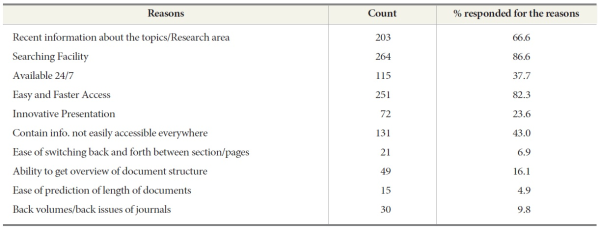
7.4.1. Types of interface(s) offered in e-journal database systems
In e-journal database systems, there are different types of interfaces offered for different categories of users.
From Table 7, a graphical based information retrieval interface (42.6%) was highly utilized by the respondents from the different subject areas and a menu-based information retrieval interface (37.4%) appeared be the second most prominent choice among the user community for their search activities.
7.4.2. Reasons behind selection of specific Interfaces in e-journal database systems
In this section, users were given the reasons for their selection of different types of interfaces offered by ejournal IR (Information Retrieval) systems. An open ended question was administered to know the reason behind the choice. In Table.8 a maximum of four reasons were analysed although responses are more than
Table 8.
Preferences given by respondents for the reasons behind selection of different type of interfaces offered by e-journal Database Systems
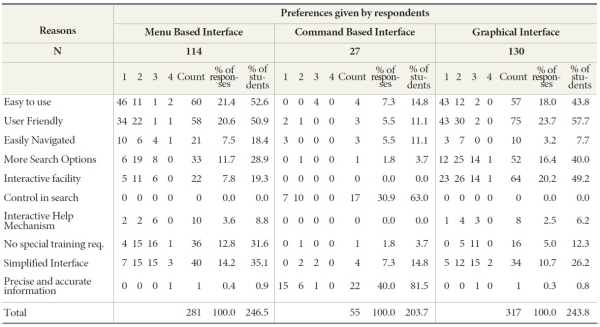
1 as well, so the frequency of responses were calculated separately as well. Here counts of responses made by the students and students' responses were calculated separately for each interface.
Here in Table 8, reasons were analysed about their preferences in regard to the selection of specific interface types in navigating e-journal database systems for the retrieval process.
For the menu- based IR interface 52.6% of students give the reason behind selecting this interface because it is “easy to use” (21.4%). After that, 50.9% of respondents give their preferences behind selecting the menu based interface because it is very “User-friendly” (20.6%). “Simplified interface” (14.2%) and “No special training required” (12.8%) also appear to be the prominent reasons behind selection of menu- based IR interfaces of e-journal database systems by respondents at 35.1% and 31.6%, respectively.
For the command- based IR interface the major reason behind selection given by the respondents are “Precise and accurate information” (40.0%) . This reason is supported by 81.5% of respondents who are using a command based IR interface. The second major reason was “Control in search” (30.9%) given by 63% of respondents.
In regard to the graphical- based IR interface which was more popular among the respondents, the reasons behind the selection of graphical- based IR interface given by the respondents are like it is very “User friendly” (23.7%) supported by 57.7% of respondents along with this reason that it also offers “interactive facilities” (20.2%). 49.2% of respondents give reasons behind selecting the specific interface. “Easy to use” (18.0%) and “More search option” (16.4%) inculcated additional advantages to make this interface more usable to users.
However, the study was user- centred and its main concentration was to analyse users online searching behavior in IR interfaces of e-journal database systems selected for the study
7.5. Knowledge of searching in the WWW Environment
The main concentration of this study was based upon IR interfaces of e-journal database systems. Accordingly in the study, user online searching behavior in IR interfaces depended upon their compatibility and friendliness with the www environment because all the selected e-journal database systems are web compatible. So, for the full potential use of selected e-journal database systems their users should be well versed in working with the WWW environments.
Here, in this section, knowledge of searching in www environment was analysed on the basis of duration of use of e-journal database systems selected for the study.
From Table 9 it is clearly shown that duration of use of e-journal database systems has a higher significant association (1% Level of significance) with the perception of knowledge in searching in the IR interfaces of e-journal database systems. Hence, respondents who were using e-journal database systems for long periods of time are more comfortable with searching in the web interfaces of e-journal database systems.
7.6. Factors involved in the formulation of effective query statements in IR interfaces of e-journal database systems
In this section, certain factors are listed which may lead to be the reasons for formulation of effective query statements. Users have to respond about which factor was most prominent for effective formulation of the query.
Table 9.
Knowledge using the web, including searching in E-journal Database Systems through duration wise

Table 10.
Factors involved for Formulating Effective Query Statement in an Interfaces of e-journal Database Systems by Different Subject Groups

Table 10 includes responses of users from different subject groups of Social Science disciplines related to the factors involved in constructing effective query statement. A Factor which was spotted by a maximum of respondents of different subject groups was “Prior Subject Knowledge”. Respondents from different subject groups considered that before searching if one has sound knowledge about the particular subject, one can formulate a very effective query statement.
7.7. Methods of formulation of Query
In an IR interface there are several ways to retrieve information. In this section, two methods were analyzed and through chi-square test and each method’s significance gets checked through the duration.
Table 11 shows the perception of users regarding searching for information in IR interfaces of e-journal database systems. Generally users prefer both ways of searching in an IR interface.
Besides that, duration of use of e-journal database systems also leads in impact to follow the different ways of searching for information in IR interface. Through chi-square testing, it shows significant association (1% level of significance) of duration on different ways of searching. From Table 11 it proves that respondents who were using e-journal database systems for more than 5yrs. follow both ways of searching methods for retrieving information.
7.8. Query Reformulation in an IR Interface
In IR Interfaces, initial queries didn’t retrieved desired results, hence user have to reformulate their queries for getting desired results. Here in Table 12
7.8.1. Sex-wise Responses related to query reformulation in IR Interface
Here, Table 12 concludes that Female respondents (78.9%) prefer using their memory for reformulating the existing query statement for getting more accurate results than male respondents (66.7%). Overall responses show that respondents prefer using “their own memory” for reformulation of query. The second most prominent factor used for search refinements supported by the respondents was by using “Reformulation with own term and synonyms” (41.6%). Respondents (35.7%) supported “Documents retrieved from the previous queries” features also for search refinements. “By using Index” gets the least response from the respondents when it comes to search refinements.
7.8.2. Duration of use of E-journal Database Systems impact on Query Reformulation
Time Period of use of e-journal database systems also plays a very important role in query reformulation. Respondents who were using e-journal database systems for more than 2-4 yrs. preferred using “From the memory” factors for formulating effective query reformulation while respondents who were using ejournal database systems for more than 5 yrs. preferred using “Documents retrieved from previous queries”.
7.9. Importance of Retrieval Features offered in an IR interfaces of e-journal database systems
In this part, respondents have to respond about the retrieval features offered in IR interfaces of e-journal database systems. To know user perception about the identified retrieval features in an IR interface, only those respondents were selected who had a searching experience with at least two of the e-journal database systems selected for the study. So, a total of 305 respondents responded regarding to difficulty and ease of use of retrieval features offered in IR interfaces of ejournal database systems.
All of the respondents were from Social Science disciplines and were selected from three central universities (i.e. JMI, DU and JNU). The users were asked about the retrieval features of the e-journal database systems, and the questioning was designed on the basis of a five point Likert scale rating of “Very Difficult”, “Difficult”, “Don’t know”, “Easy”, and “Very Easy” where Very Difficult had the maximum value 5 while Very Easy rated as 1.
Here, responses of users were analysed by using Standard deviation and Mean.
From Table 14 it clearly shows that users from different e-journal database systems give a mixed reaction about the enlisted retrieval features offered in IR interfaces of e-journal database systems. The study shows the mixed reaction on the retrieval features offered by IR interfaces of e-journal database systems. It has been observed that in EBSCO, users rated the formulation of search term by using Boolean search operator as having the highest mean value 3.31 which shows that users are not aware of this search functionality offered by the interface of EBSCO, whereas “Subject search” rated as lowest mean 1.71 which suggest that formulation of query by using this search operator is easier. With Emerald, users rated Boolean search with highest mean value 3.70 noting that formulating search statement by using Boolean search operator was rated difficult by the respondents while “Range search” was rated as lowest mean value 1.70; this indicate that by using range search options formulation of query is easy in search interface of e-journal database systems.
In ProQuest, again Boolean search rated as highest with mean value 3.47 while “Article type search” rated as lowest high mean value 1.71. In JSTOR, Boolean search rated as highest mean value 3.31 whereas “subject search” rated as lowest mean value 1.71. Wilson Web also rated Boolean search as a highest mean value 3.74 and “Article type search” rated as lowest mean value 1.63. In Springer, highest mean value rated as 3.12 for Boolean search feature offered by IR interface and “subject search” rated as lowest mean value 1.71. But again in Project MUSE, Boolean search rated as a highest mean value 3.38 and for subject search it was rated as lowest mean value 1.66. In Sage interface again “Boolean search rated as high mean value 3.26” which indicates that users were not much aware of this search operator in formulation of their search query while “Subject search” rated as lowest meant value 1.70 by respondents who feel comfortable in formulating search query by using this search operator for formulation of search statements. With highest mean value 3.06, Boolean search again appear to be unknown to the respondents of OUP in their search related activities while “subject search” has lowest mean value. In T&F online, here also “Boolean search” also rated as
highest mean value 3.26 and “Subject search” rated as lowest mean value 1.68.
Hence, it can be concluded that the users from each e-journal database system find themselves at ease while formulating their search statements with the help of ‘Field Specific Searches’, ‘Range Search’, ‘Subject Search’, ‘Citation Search’, ‘Cross- ref Search’ and ‘Article Type Search’. The mixed reaction comes up from the users’ point of view, i.e. use of Boolean Search, though most of the respondents were not aware of this search operator, but respondents from EMERALD and Wilson Web were aware of these Boolean Search operators but they experience difficulty in formulation of search statement by using Boolean search operators.
From Table 14 it clearly shown that users prefer menu based searching and find themselves at ease when using menus or pull down options incorporated with various search operators rather than command based searching in IR interfaces of e-journal database systems.
7.9.1. Importance of Retrieval Features offers in IR interfaces of e-journal database systems (Subject- Wise distribution)
User experience with these enlisted search operators offered by IR interfaces of e-journal database systems were analysed through various subject groups which were chosen for the study within Social Science disciplines. To know user perceptions hailing from different subjects regarding these search operators and which operators they find effective in their search related activities is also very important for the study. Here in Table 15 users experience were analysed through Mean and in bracketed numbers through Standard Deviation.
Table 15 elaborates the users’ perceptions towards the effectiveness of search operators in their information retrieval tasks. Respondents from Economics rated ‘Boolean search’ with highest mean value 3.50 with inefficient standard deviation 1.00, though a maximum of respondents from Economics subject groups were using Boolean Search; but formulation of search statement by using Boolean Operators creates difficulty while ‘Subject search’ was rated with lowest mean value 1.59. Users’ frequently use this retrieval feature for getting information and found it easy to use. Respondents from Education again find ‘Boolean Operators’ difficult to use and rated them with highest mean value 3.50 with efficient standard deviation 0.71, while again subject search was rated with lowest mean value 1.70 with less efficient standard deviation 0.68. ‘Wildcard and truncation’ recorded highest mean value 3.26 with efficient standard deviation 0.57 from
Table 15.
Users Experience falling under Different Subject Groups with Retrieval Features offered by IR interface of e-journal database systems
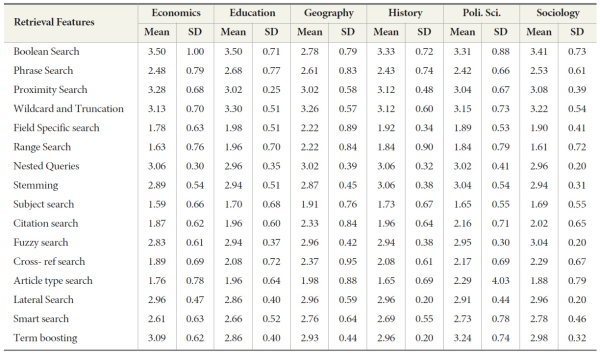
Geography respondents, but most of the users who are hailing from Geography streams were not aware of this search operator and at the same time ‘subject search’ again was rated with lowest mean value 1.91. ‘Boolean search’ appeared with highest mean value 3.33 by the History students while ‘Article type search’ got lowest mean value 1.65 with less efficient standard deviation 0.69.
So, from Table 15 a clear vision is presented that not all respondents but half of the respondents selected for the study were aware of Boolean Operators and use of this operator in their search process, but they felt difficulty while using Boolean Search operators. Apart from this, most of the search operators were not much in use by the respondents like truncation &Wildcard Search, Proximity search, Rules of Precedence and Nested Queries, and so on. It shows that respondents from different subject groups of Social Science disciplines do not prefer using command searching.
So, for knowing the retrieval effectiveness of these search operators offered in IR interface of e-journal database systems ,Cross- Average Mean analyses of various search features offered in IR interface of ejournal database systems were analysed through One Way ANOVA testing.
Table 16.
One way ANOVA for determining the Retrieval Effectiveness of Search Operators for E-journal Database Systems
* 1% significant. ** 5% significant. *** 10% significant
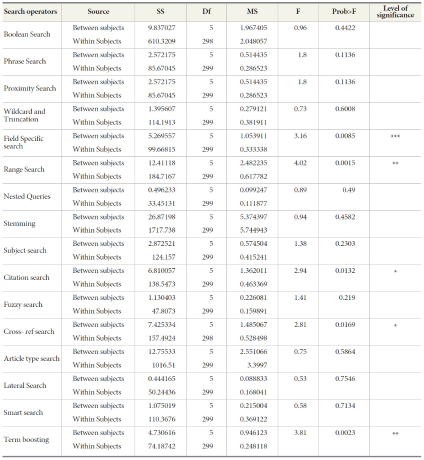
A set of one way ANOVA has been done on each of the retrieval features by Subject and it has been found that for a few features such as ‘Field specific searches’, ‘Range Search’, 'Citation search’, ‘Cross-ref search’ and ‘Term boosting’ there has been significant variation found among other listed retrieval features by the respondents from different subject groups. Among all listed retrieval features, ‘Citation Search’ and ‘Cross- Ref search’ show a high level of significant difference (1% level of significance) among the respondents while Term Boosting and Range search shows a significant difference (5% level of significance) among other retrieval features. So, here in the study, it is found that among all the listed retrieval features there is some significant difference found in terms of offering search operators in IR interface and it leaves their impact on the retrieved results.
7.9. Browsing in an IR interfaces of e-journal database systems
In an IR interfaces of e-journal database systems, there are several ways offered to the users for browsing the information. Here in Table 15, browsing features are mentioned
From Table 17 it clearly shown that respondents basically used “References of the articles” for browsing more information related to their search needs. Respondents also preferred “Downloading material ‘read’ later” when it comes to browsing information in an IR interface. There is one more method of browsing which was very popular among respondents, i.e. “Reading abstract and titles rather than full-text” (49.84%). Journal TOCs was yet another feature that may provide help to the respondents in case of browsing. The least effective browsing features was “collecting information from different sites” which scored less.
Table 17 discusses the preference of respondents dealing with different education arenas. Ph.D. students browse the information in an IR interface of e-journal database systems by using “References of the articles” (78.5%) over M.Phil. students who prefer this approach only at 61.6%. “Downloading material and read later” appears to be the second most prominent approach followed by the respondents from both the Education groups. The least preferred approach followed by the respondents of both M.Phil. and Ph.D. was “collecting information from different sites.”
8. CONCLUSION
All e-journal database systems used for the study were commercial ones. So, they all follow accepted guidelines and standards to make their IR interfaces more usable to user. So, with technological advancement all e-journal database systems offers their IR interfaces in combination of both menu- based and command- based searching that provide assistance to users in their diversified search activities. But from the study it is clearly shown that users prefer menu- based searching where they select search operators through pull-down menus. Most of the respondents were not aware of command- based searches. Every individual has a distinctive way of searching in an IR interface of e-journal database systems but from the study it is clearly shown that the impacts of online searching behaviours of the students were basically based on duration of use of e-journal database systems and their subject knowledge meaning how much they well versed with their respective subjects.
So, this study also gives ideas to database vendors that users prefer only those search operators which provide them with more related information by entering a single search statement. Command- based searches were not grabbing much attention among the user community. Respondents find command based searching less usable in their retrieval process.
8.1. Further Research
The findings from such research can assist with a better understanding of the use of IR interfaces of ejournal database systems for their retrieval process and also made users aware of various search operators available in IR interfaces of e-journal database systems.
In designing the user interfaces of e-journal database systems, user feedback is very necessary. So, in future, the main concentration will be on user interface design for both types of users: novice and experienced users. For that, different tasks and sub-tasks with different requirements will be assigned to users and by recording their ways of accomplishing tasks in the interface and the types of support users need from the interface and the level of control required in the interface for their retrieval process will all need to be studied.
References
((2003), Retrieved May 5, 2011) Database evaluation report: Expanded Academic ASAP vs Academic Search Premier from http://liweb/hawaii.edu/uhmlib/news/surveys/eai_asap.htm
((1998), Retrieved November 5, 2012) Improving subject retrieval: User-friendly interfaces and effectiveness from www.ub.edu/bid/01espel1.htm
((2009), Retrieved on September 11, 2010) Is Searching Full text more effective than searching abstracts? BMC Bioinformatics, 1-15 from http://www .biomedcentral.com/1471-2105/10/46
(Retrieved October 14, 2010) Basic database searching techniques (Information Commons), Libraries from. http://www.libraries.iub.edu/index.php?pageId=1480
((1998), Retrieved on September 12, 2010) Find It on the Web using the Search concepts you already know, Library Media Connection, 56-58 From http://web.ebscohost.com/ehost/pdfviewer/pdfviewer?sid=14a109c6-9e36-4266-a1c1-a77a47480ea8%40sessionmgr104&vid=1&hid=125
- Submission Date
- 2013-05-27
- Revised Date
- Accepted Date
- 2013-11-19
- Downloaded
- Viewed
- 0KCI Citations
- 0WOS Citations


